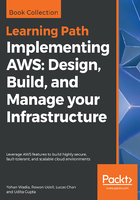
What this book covers
Chapter 1, What's New in AWS?, contains a brief introduction to some of the key enhancements and announcements made to the existing line of AWS services and products.
Chapter 2, Managing EC2 with Systems Manager, provides a brief introduction to using EC2 Systems Manager to manage your fleet of EC2 instances. It also covers an in-depth look at how to work with SSM agents, Run Command, as well as other systems manager features, such as automation, patching, and inventory management.
Chapter 3, Introducing Elastic Beanstalk and Elastic File System, explains how to leverage both Elastic Beanstalk and the Elastic File Systems services to build and scale out web applications and deploy them with absolute ease.
Chapter 4, Securing Workloads Using AWS WAF, discusses some of the key aspects that you can leverage to provide added security for your web applications using AWS WAF and AWS Shield. The chapter also provides some keen insights into how you can protect your
web applications against commonly occurring attacks such as cross-site scripting and SQL injections.
Chapter 5, Governing Your Environments Using AWS CloudTrail and AWS Config, introduces you to the concept and benefits provided by leveraging AWS CloudTrail and AWS Config. The chapter covers in-depth scenarios using which you can standardize governance and security for your AWS environments.
Chapter 6, Access Control Using AWS IAM and AWS Organizations, takes a look at some of the latest enhancements made to the AWS IAM service. It also walks you through how you can manage your AWS accounts with better efficiency and control using AWS organizations as a Service.
Chapter 7, Transforming Application Development Using the AWS Code Suite, covers an indepth look at how you can leverage CodeCommit, CodeDeploy, and CodePipeline to design and build complete CICD pipelines for your applications.
Chapter 8, Powering Analytics Using Amazon EMR and Amazon Redshift, provides practical knowledge and hands-on approach to process and a run large-scale analytics and data warehousing in the AWS Cloud.
Chapter 9, Orchestrating Data Using AWS Data Pipeline, covers how you can effectively orchestrate the movement of data from one AWS service to another using simple, reusable pipeline definitions.
Chapter 10, Managing AWS Accounts, covers everything you need to know to manage your accounts and get started with AWS organizations.
Chapter 11, Using AWS Compute, dives deep into how to run VMs (EC2 instances) on AWS, how to auto scale them, and how to create and manage load balancers.
Chapter 12, Management Tools, provides an overview of how to audit your account and monitor your infrastructure.
Chapter 13, Database Services, shows you how to create, manage, and scale databases on the AWS platform.
Chapter 14, Introducing AWS Lambda, covers the introductory concepts and general benefits of serverless computing, along with an in-depth look at AWS Lambda. The chapter also walks you through your first steps with AWS Lambda, including deploying your first functions using the AWS Management Console and the AWS CLI.
Chapter 15, Writing Lambda Functions, covers the fundamentals of writing and composing your Lambda functions. The chapter introduces you to concepts such as versioning, aliases, and variables, along with an easy-to-follow code sample.
Chapter 16, Testing Lambda Functions, discusses the overall importance of testing your function for code defects and bugs. It also introduces you to some out-of-the-box testing frameworks in the form of Mocha and Chai, and summarizes it all by demonstrating how you can test your functions locally before actual deployments to Lambda.
Chapter 17, Event-Driven Model, introduces the concept of the event-based system and how it actually works. The chapter also provides a deep dive into how Lambda's event-based model works with the help of event mappings and a few easy-to-replicate, real-world use cases.
Chapter 18, Extending AWS Lambda with External Services, discusses the concept and importance of Webhooks and how they can be leveraged to connect your serverless functions with any third-party services. The chapter also provides a few real-world use
cases, where Lambda functions are integrated with other services such as Teamwork, GitHub, and Slack.
Chapter 19, Build and Deploy Serverless Applications with AWS Lambda, provides you with a hands-on approach to building scalable serverless applications using AWS services such as SAM and Step Functions with a few handy deployment examples.
Chapter 20, Monitoring and Troubleshooting AWS Lambda, covers how you can leverage AWS CloudWatch and X-ray to monitor your serverless applications. The chapter also introduces other third-party tools, such as Datadog and Loggly, for effectively logging and monitoring your functions.
Chapter 21, AWS Lambda - Use Cases, provides a comprehensive set of real-world serverless use cases with some easy-to-follow code examples and snippets.
Chapter 22, Next Steps with AWS Lambda, summarizes the next phase in the evolution of serverless applications and discusses how new and improved enhancements in Lambda are expected to come about in the near future.